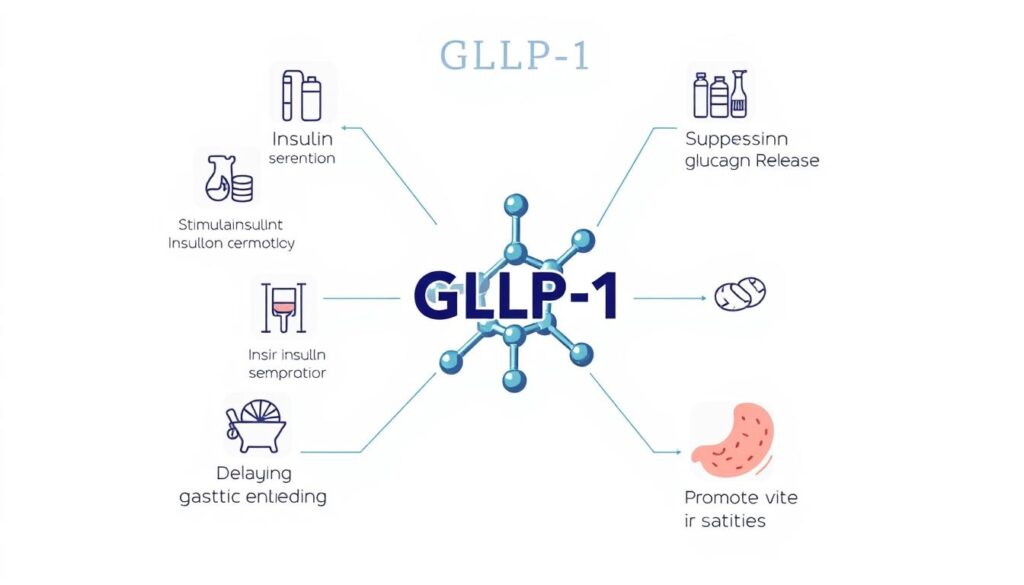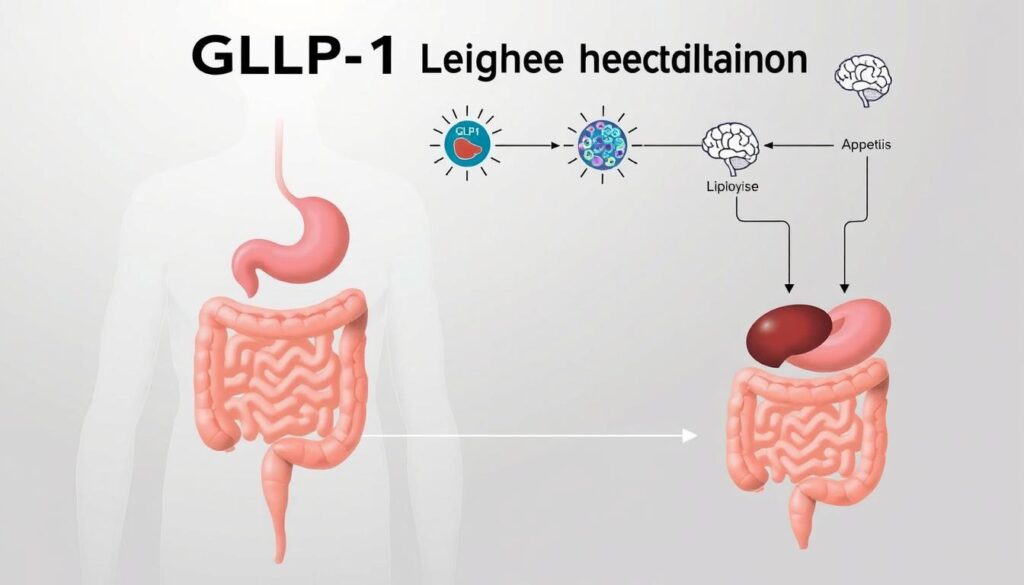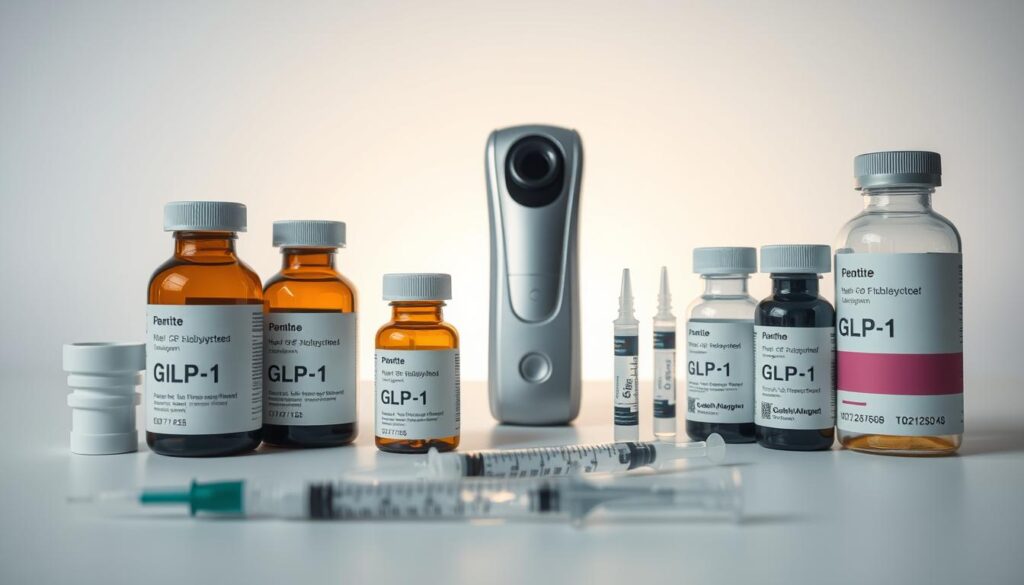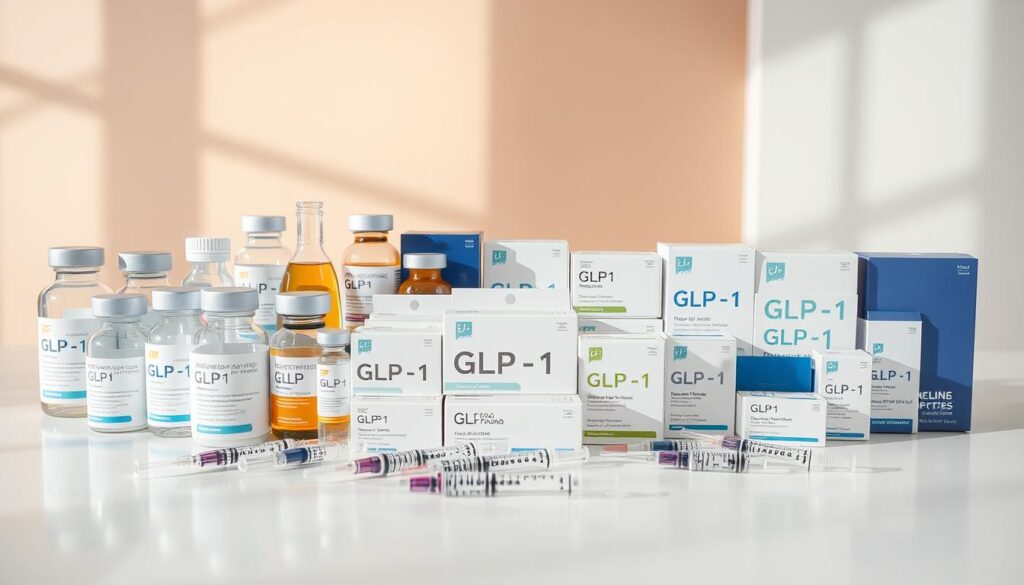Effective weight management is a challenge many face, and recent advancements have highlighted the crucial role of Glucagon-like peptide 1 (GLP-1) in this process.
GLP-1 is a naturally occurring hormone that plays a significant role in regulating appetite and improving metabolic health. Medications that mimic this hormone have shown promising results in aiding weight loss and enhancing overall health.
By understanding how GLP-1 works and its benefits, individuals can make informed decisions about their weight management strategies. The use of GLP-1 medications represents a valuable tool for those struggling with weight loss.
Key Takeaways
- GLP-1 is a hormone that regulates appetite and metabolic health.
- GLP-1 medications aid in weight loss and improve overall health.
- Understanding GLP-1’s role is crucial for effective weight management.
- GLP-1 medications are a valuable tool for weight loss.
- GLP-1 improves metabolic health and regulates appetite.
Understanding GLP-1: The Weight Management Hormone
GLP-1 is a naturally occurring hormone in the body that plays a crucial role in regulating appetite and metabolism. It is secreted by the intestines in response to food intake and has been shown to have a significant impact on glucose control and weight management.

What is GLP-1?
GLP-1, or Glucagon-Like Peptide-1, is an incretin hormone that is involved in the regulation of blood glucose levels. It enhances the secretion of insulin from the pancreas, suppresses the release of glucagon, and slows gastric emptying, thereby reducing postprandial glucose peaks.
The Natural Role of GLP-1 in the Body
The natural role of GLP-1 in the body is multifaceted. It not only regulates glucose metabolism but also affects appetite and satiety. By activating GLP-1 receptors in the brain, it helps reduce hunger and increase feelings of fullness, making it a key player in weight management. The GLP-1 receptor is crucial for its function, as it mediates the hormone’s effects on various tissues.
Understanding the GLP-1 function and its benefits is essential for appreciating its role in weight loss and glucose control. The benefits of GLP-1 include improved glycemic control, weight loss, and potentially reduced cardiovascular risk factors.
The Science Behind GLP-1 for Weight Loss
The effectiveness of GLP-1 in weight loss can be attributed to its multifaceted mechanism of action. GLP-1, or Glucagon-Like Peptide-1, is a naturally occurring hormone in the body that plays a significant role in regulating appetite, satiety, and metabolism.

How GLP-1 Affects Appetite and Satiety
GLP-1 agonists work by mimicking the action of the natural GLP-1 hormone, helping to reduce hunger and increase feelings of fullness. This dual effect supports individuals in achieving and maintaining weight loss. Studies have shown that GLP-1 therapy can lead to significant reductions in body weight.
- Reduces hunger
- Increases feelings of fullness
- Supports weight loss
GLP-1’s Impact on Metabolism
Beyond its effects on appetite, GLP-1 also influences metabolic processes. It enhances insulin secretion in response to high blood glucose levels, improving glycemic control. Moreover, GLP-1 has been shown to have beneficial effects on lipid metabolism.
- Enhances insulin secretion
- Improves glycemic control
- Beneficial effects on lipid metabolism
Research Supporting GLP-1 for Weight Management
Numerous studies have demonstrated the efficacy of GLP-1 therapy in weight management. Clinical trials have shown that participants receiving GLP-1 receptor agonists experience significant weight loss compared to those on placebo. The evidence supports GLP-1 as a valuable treatment option for obesity.
By understanding the science behind GLP-1 and its effects on the body, individuals can make informed decisions about incorporating GLP-1 therapy into their weight loss regimen.
Types of GLP-1 Medications Available Today
Patients now have access to a variety of GLP-1 medications, including injectable and oral formulations, to aid in their treatment plans. This diversity in treatment options allows healthcare providers to tailor therapies to individual patient needs.
Injectable GLP-1 Receptor Agonists
Injectable GLP-1 receptor agonists are a cornerstone in the treatment of type 2 diabetes and have shown efficacy in weight management. These medications mimic the action of the natural hormone GLP-1, enhancing glucose-dependent insulin secretion, and are administered via injection. Examples include semaglutide and liraglutide, which have been shown to improve glycemic control and support weight loss.

Oral GLP-1 Medications
Oral GLP-1 medications represent a newer class of treatments that offer the convenience of oral administration. While still in the early stages compared to injectables, oral GLP-1 medications provide an alternative for patients who may struggle with injections. Research is ongoing to fully understand their efficacy and potential benefits.
Combination Therapies
Combination therapies involving GLP-1 receptor agonists and other medications are being explored to enhance treatment outcomes. By combining GLP-1 agonists with other agents, such as metformin or SGLT2 inhibitors, healthcare providers can address multiple aspects of diabetes and obesity management simultaneously.
The range of GLP-1 medications available today underscores the advancements in treating diabetes and obesity, offering hope for more effective management strategies.
Popular GLP-1 Products on the Market
The most widely used GLP-1 medications have been semaglutide, liraglutide, and tirzepatide, each with unique characteristics.
Semaglutide (Wegovy, Ozempic)
Overview
Semaglutide is a GLP-1 receptor agonist used for both weight management and glucose control. It is marketed under different brand names for different indications.
Pros
- Effective Weight Loss: Clinical trials have shown significant weight loss in patients using semaglutide.
- Cardiovascular Benefits: There is evidence suggesting cardiovascular benefits associated with semaglutide use.
Cons
- Gastrointestinal Side Effects: Common side effects include nausea and diarrhea.
- Injection Site Reactions: Some patients may experience reactions at the injection site.
Features
Semaglutide is administered via injection once a week. Its dosing regimen is designed to be convenient for patients.

Liraglutide (Saxenda)
Overview
Liraglutide is another GLP-1 receptor agonist used for weight loss and improving glycemic control.
Pros
- Proven Efficacy: Liraglutide has been shown to be effective in clinical trials for weight loss.
- Daily Dosing: It is administered once daily, which can be beneficial for some patients.
Cons
- Common Side Effects: Nausea and vomiting are among the common side effects.
- Cost: Liraglutide can be expensive, depending on insurance coverage.
Features
Liraglutide is available in a pre-filled pen for easy administration.
Tirzepatide (Mounjaro)
Overview
Tirzepatide is a dual GIP/GLP-1 receptor agonist, representing a new class of medications for weight loss and glucose control.
Pros
- Dual Mechanism: Its unique mechanism of action may offer additional benefits.
- Significant Weight Loss: Clinical trials have demonstrated substantial weight loss with tirzepatide.
Cons
- Limited Long-term Data: As a newer medication, long-term safety and efficacy data are still being gathered.
- Potential Side Effects: Gastrointestinal side effects are common.
Features
Tirzepatide is administered via injection once a week, similar to semaglutide.
| Medication | Dosing Frequency | Notable Benefits | Common Side Effects |
|---|---|---|---|
| Semaglutide | Once Weekly | Significant weight loss, cardiovascular benefits | Nausea, diarrhea, injection site reactions |
| Liraglutide | Once Daily | Proven efficacy for weight loss | Nausea, vomiting, cost |
| Tirzepatide | Once Weekly | Dual mechanism, significant weight loss | Gastrointestinal side effects, limited long-term data |
Clinical Efficacy of GLP-1 Therapy
GLP-1 therapy has emerged as a groundbreaking approach in the realm of weight management. Clinical trials have shown that GLP-1 medications can lead to significant weight loss and improvements in metabolic health.

Average Weight Loss Results
Studies have consistently demonstrated that GLP-1 receptor agonists result in substantial weight loss. For instance, a clinical trial involving semaglutide reported an average weight loss of 15-20% of initial body weight over 68 weeks.
- Significant weight loss observed in clinical trials
- Average weight loss ranges from 10-20% of initial body weight
- Variability in results depending on the specific GLP-1 medication used
Timeframe for Seeing Results
The timeframe for observing weight loss results with GLP-1 therapy can vary. Typically, patients begin to notice weight loss within the first few weeks of treatment, with more pronounced effects seen after 12-16 weeks.
- Initial weight loss often observed within 4-6 weeks
- Significant weight loss typically achieved by 12-16 weeks
- Continued treatment leads to sustained weight loss over time
Long-term Effectiveness
Long-term studies have shown that GLP-1 therapy can maintain its efficacy over extended periods. For example, a 2-year study on liraglutide demonstrated sustained weight loss and improved metabolic parameters.
Key factors influencing long-term effectiveness include:
- Adherence to treatment regimen
- Lifestyle modifications such as diet and exercise
- Regular monitoring and adjustment of treatment as needed
GLP-1 Benefits Beyond Weight Loss
Beyond their weight loss effects, GLP-1 receptor agonists offer several other health benefits. These medications have been shown to have a positive impact on various aspects of health, making them a valuable treatment option for individuals with specific health conditions.
Improvements in Blood Sugar Control
One of the significant benefits of GLP-1 medications is their ability to improve blood sugar control. By enhancing insulin secretion and decreasing glucagon levels, GLP-1 receptor agonists help manage blood glucose levels more effectively. This is particularly beneficial for individuals with type 2 diabetes, as it can lead to better glycemic control and reduced risk of diabetes-related complications.

Cardiovascular Benefits
GLP-1 medications have also been associated with cardiovascular benefits. Studies have shown that these medications can reduce the risk of major adverse cardiovascular events, such as heart attacks and strokes, in patients with established cardiovascular disease. This makes GLP-1 therapy a valuable option for individuals at high cardiovascular risk.
Potential Reduction in Obesity-Related Complications
In addition to weight loss and improved blood sugar control, GLP-1 medications may also reduce the risk of obesity-related complications. By addressing the underlying hormonal imbalances that contribute to obesity, GLP-1 receptor agonists can help mitigate the risk of developing conditions such as certain types of cancer, osteoarthritis, and fatty liver disease.
Overall, GLP-1 therapy offers a multifaceted approach to improving health outcomes, making it a promising treatment option for individuals with obesity, type 2 diabetes, and cardiovascular disease.
Potential Side Effects and Risks of GLP-1
While GLP-1 therapy offers significant benefits for weight loss, it’s crucial to understand the possible risks involved. GLP-1 medications, like any other treatment, can cause side effects ranging from mild to severe.
Common Side Effects
The most frequently reported side effects of GLP-1 receptor agonists include nausea, vomiting, and diarrhea. These gastrointestinal symptoms are often mild to moderate and tend to decrease over time as the body adjusts to the medication. It’s essential for patients to be aware of these potential side effects and discuss any concerns with their healthcare provider.

Serious Adverse Events
Although less common, serious adverse events can occur with GLP-1 therapy. These may include pancreatitis, thyroid C-cell tumors, and acute kidney injury. Patients with a history of pancreatitis or thyroid disease should exercise caution and consult their healthcare provider about the potential risks. Additionally, GLP-1 medications have been associated with an increased risk of gallbladder disease.
Risk Management Strategies
To minimize the risks associated with GLP-1 therapy, several strategies can be employed. Patients should be closely monitored by their healthcare providers, and regular check-ups can help identify any potential issues early on. Dose adjustments or alternative treatments may be considered if side effects become problematic. Furthermore, patient education on the proper administration of GLP-1 medications and lifestyle modifications can also help mitigate risks.
By understanding the potential side effects and risks of GLP-1 therapy and implementing effective risk management strategies, patients can maximize the benefits of their treatment while minimizing adverse events.
Who Should Consider GLP-1 Therapy?
Determining the suitability of GLP-1 therapy involves understanding several key factors. GLP-1 medications are typically prescribed for individuals with obesity or those who are at risk of developing obesity-related complications.
Ideal Candidates
Ideal candidates for GLP-1 therapy are those with a BMI of 30 or higher, or a BMI of 27 or higher with at least one weight-related condition such as type 2 diabetes, hypertension, or dyslipidemia. GLP-1 therapy is particularly beneficial for individuals who have not achieved significant weight loss through diet and exercise alone.

Contraindications
GLP-1 therapy is not suitable for everyone. Contraindications include a personal or family history of medullary thyroid carcinoma, multiple endocrine neoplasia syndrome type 2, and known hypersensitivity to the active substance or any of the excipients. It’s crucial to discuss your medical history with your healthcare provider to determine if GLP-1 therapy is safe for you.
Pre-existing Conditions to Consider
Pre-existing conditions such as pancreatitis, gallbladder disease, and renal impairment require careful consideration before starting GLP-1 therapy. A thorough evaluation by a healthcare provider is necessary to weigh the benefits and risks.
| Condition | Considerations for GLP-1 Therapy |
|---|---|
| Pancreatitis | History of pancreatitis requires caution; monitor for signs of pancreatitis |
| Gallbladder Disease | Rapid weight loss may increase the risk of gallstones |
| Renal Impairment | Dose adjustments may be necessary for patients with renal impairment |
By carefully evaluating ideal candidates, contraindications, and pre-existing conditions, healthcare providers can help patients make informed decisions about GLP-1 therapy.
The Patient Experience: What to Expect
The journey with GLP-1 therapy is multifaceted, involving treatment, lifestyle changes, and support. As patients start this journey, understanding what to expect can significantly enhance their experience and outcomes.
Starting GLP-1 Treatment
When initiating GLP-1 therapy, patients should first consult with their healthcare provider to discuss their medical history, current health status, and any concerns they may have. This initial consultation is crucial for tailoring the treatment plan to the individual’s needs. It’s essential to follow the healthcare provider’s guidance on dosing and administration to ensure the medication’s effectiveness and minimize potential side effects.
Dosing and Administration
Dosing and administration of GLP-1 medications vary depending on the specific product prescribed. For instance, medications like Semaglutide are administered via injection once a week. Proper administration techniques are vital for the medication’s efficacy and safety. Patients should be trained on how to self-administer the medication correctly.

Lifestyle Modifications to Enhance Results
In addition to the medication, certain lifestyle modifications can enhance the results of GLP-1 therapy. These include adopting a healthy diet, increasing physical activity, and maintaining a consistent sleep schedule. Combining these lifestyle changes with GLP-1 therapy can lead to more significant weight loss and overall health improvements.
By understanding the patient experience and what to expect from GLP-1 therapy, individuals can better prepare themselves for the journey ahead. With the right mindset, support, and treatment plan, patients can maximize the benefits of GLP-1 therapy.
Cost and Insurance Coverage
Understanding the financial aspects of GLP-1 therapy is crucial for individuals considering this weight management approach. The cost of these medications can vary significantly based on several factors, including the specific medication, dosage, and frequency of administration.
Price Range for Different GLP-1 Medications
The prices for GLP-1 medications like Semaglutide (Wegovy, Ozempic) and Liraglutide (Saxenda) can differ substantially. For instance, the list price for Wegovy can be around $1,300 per month, although actual costs may vary based on insurance coverage and pharmacy discounts. It’s essential to check with pharmacies and insurance providers for the most accurate pricing.
Insurance Coverage Landscape
Insurance coverage for GLP-1 medications is not uniform and can vary widely among different insurance providers. Some plans may cover certain GLP-1 receptor agonists for diabetes management but not for weight loss. Patients should review their insurance policies or consult with their insurance representatives to understand what is covered.
Patient Assistance Programs
For individuals facing high out-of-pocket costs, patient assistance programs can be a valuable resource. These programs, offered by pharmaceutical companies, can help reduce the financial burden. For example, manufacturers of popular GLP-1 medications often have programs that provide discounts or free medication to eligible patients.
By understanding the cost, exploring insurance coverage options, and leveraging patient assistance programs, individuals can make GLP-1 therapy more accessible and affordable.
Comparing GLP-1 to Other Weight Management Approaches
In the realm of weight management, comparing GLP-1 therapy to other treatments reveals distinct advantages and disadvantages. As obesity rates continue to rise, understanding the effectiveness of different weight management strategies becomes crucial.
GLP-1 vs. Traditional Diet and Exercise
GLP-1 therapy offers a pharmacological approach that can be more effective for some individuals compared to traditional diet and exercise alone. While lifestyle modifications remain a cornerstone of weight management, GLP-1 medications can enhance weight loss efforts by regulating appetite and improving metabolic health.
GLP-1 vs. Other Weight Loss Medications
When compared to other weight loss medications, GLP-1 receptor agonists have shown significant promise in clinical trials. They not only facilitate weight loss but also offer additional health benefits, such as improved blood sugar control and cardiovascular advantages.
GLP-1 vs. Bariatric Surgery
Bariatric surgery is a highly effective weight loss intervention, but it is invasive and carries surgical risks. GLP-1 therapy, on the other hand, is a non-surgical option that can be effective for sustained weight loss without the risks associated with surgery. However, the choice between GLP-1 therapy and bariatric surgery depends on individual health circumstances and the severity of obesity.
In conclusion, GLP-1 therapy represents a valuable option in the spectrum of weight management approaches, offering a balance between efficacy and safety. By understanding how GLP-1 compares to other treatments, healthcare providers and patients can make more informed decisions about the best weight management strategy.
Recommendations for Using GLP-1 Products
When used correctly, GLP-1 receptor agonists can be a powerful tool in the fight against obesity, but certain recommendations should be followed. To achieve optimal results, patients must work closely with their healthcare providers and adhere to best practices.
Best Practices for Optimal Results
To maximize the benefits of GLP-1 therapy, patients should start with a thorough consultation with their healthcare provider to discuss their medical history, current health status, and weight loss goals. “A well-informed patient is better equipped to navigate the treatment process,” says Dr. Jane Smith, a leading expert in obesity management.
It’s also crucial to follow the prescribed dosing regimen and administration instructions carefully. Patients should be aware of the potential side effects and report any concerns to their healthcare provider promptly.
Who Will Benefit Most from Each Product
Different GLP-1 products may be more suitable for different patients based on factors such as their specific health conditions, other medications they’re taking, and their personal preferences regarding administration methods (e.g., injectable vs. oral).
- Semaglutide (Wegovy, Ozempic) is often recommended for patients with type 2 diabetes or those who require a more potent GLP-1 receptor agonist.
- Liraglutide (Saxenda) is another option that has been shown to be effective for weight loss in appropriate candidates.
Monitoring Progress and Adjusting Treatment
Regular monitoring of progress is essential to determine the effectiveness of the GLP-1 therapy and to make any necessary adjustments to the treatment plan. This includes tracking weight loss, improvements in metabolic markers, and any side effects.
“Regular check-ins with healthcare providers allow for timely adjustments to the treatment plan, ensuring the patient remains on track to meet their weight loss goals,” notes Dr. John Doe.
Working with Healthcare Providers
A collaborative approach between the patient and healthcare provider is vital for the success of GLP-1 therapy. This includes not only the initial consultation but also ongoing support and guidance throughout the treatment process.
By following these recommendations and working closely with healthcare providers, patients can maximize the benefits of GLP-1 products and achieve their weight loss goals more effectively.
Real Patient Stories and Testimonials
Real patient stories provide a compelling insight into the benefits and challenges of GLP-1 therapy. By sharing their experiences, patients offer a nuanced understanding of what to expect from this weight management approach.
Success Stories
Many patients have achieved significant weight loss with GLP-1 therapy. For instance, Sarah, a 45-year-old woman, lost 25 pounds in six months using semaglutide. Her journey was not without challenges, but the support of her healthcare provider and her own dedication made a significant difference.
Another success story is that of John, who, after struggling with obesity for years, found success with liraglutide. He experienced not only weight loss but also improvements in his blood sugar control.
Challenges and Setbacks
While GLP-1 therapy has been life-changing for many, it’s not without its challenges. Some patients experience side effects such as nausea or injection site reactions. However, these can often be managed with the right guidance from healthcare providers.
For example, Emily initially experienced nausea when starting tirzepatide, but by adjusting her dosage and administration technique, she was able to continue her treatment successfully.
Long-term Maintenance Experiences
Long-term success with GLP-1 therapy requires ongoing commitment. Patients often need to continue their medication to maintain weight loss. A study on the long-term efficacy of GLP-1 receptor agonists showed sustained weight loss over two years.
| Medication | Average Weight Loss | Common Side Effects |
|---|---|---|
| Semaglutide | 15-20% | Nausea, Diarrhea |
| Liraglutide | 10-15% | Nausea, Injection site reactions |
| Tirzepatide | 15-22% | Nausea, Vomiting |
By examining these patient stories and testimonials, it’s clear that GLP-1 therapy can be a highly effective tool for weight management, offering not just weight loss but also improvements in overall health.
Conclusion
GLP-1 therapy has emerged as a groundbreaking approach to weight management, offering a new horizon for individuals struggling with obesity and related health issues. By mimicking the natural hormone GLP-1, these treatments help regulate appetite, improve satiety, and enhance metabolic health.
The effectiveness of GLP-1 therapy is backed by substantial research, demonstrating significant weight loss and improvements in overall health, including better blood sugar control and cardiovascular benefits. Popular GLP-1 products like semaglutide (Wegovy, Ozempic), liraglutide (Saxenda), and tirzepatide (Mounjaro) have shown promising results, providing patients with a range of treatment options.
As we conclude, it’s clear that GLP-1 therapy represents a valuable tool in the fight against obesity. For those considering this treatment, it’s essential to consult with healthcare providers to determine the best course of action and to understand the potential benefits and risks. With the right guidance, individuals can harness the power of GLP-1 therapy to achieve their weight management goals and improve their overall quality of life.
FAQ
What is GLP-1 and how does it work for weight loss?
What are the different types of GLP-1 medications available?
What are the benefits of GLP-1 therapy beyond weight loss?
What are the common side effects of GLP-1 medications?
Who is a good candidate for GLP-1 therapy?
How much weight can I expect to lose with GLP-1 therapy?
How long does it take to see results with GLP-1 therapy?
How much do GLP-1 medications cost, and are they covered by insurance?
FAQ
What is GLP-1 and how does it work for weight loss?
GLP-1, or glucagon-like peptide-1, is a hormone that plays a crucial role in regulating appetite and glucose control. GLP-1 medications, such as semaglutide and liraglutide, work by mimicking the natural hormone, helping to reduce hunger and increase feelings of fullness, leading to weight loss.
What are the different types of GLP-1 medications available?
There are several types of GLP-1 medications available, including injectable GLP-1 receptor agonists, oral GLP-1 medications, and combination therapies. Injectable GLP-1 receptor agonists, such as semaglutide and liraglutide, are administered via injection, while oral GLP-1 medications are taken orally.
What are the benefits of GLP-1 therapy beyond weight loss?
GLP-1 therapy has been shown to have numerous benefits beyond weight loss, including improvements in blood sugar control, cardiovascular health, and potential reduction in obesity-related complications.
What are the common side effects of GLP-1 medications?
Common side effects of GLP-1 medications include nausea, vomiting, diarrhea, and abdominal pain. Serious adverse events, such as pancreatitis and thyroid C-cell tumors, are rare but can occur.
Who is a good candidate for GLP-1 therapy?
Ideal candidates for GLP-1 therapy are individuals with a BMI of 30 or higher, or those with a BMI of 27 or higher with at least one weight-related condition, such as type 2 diabetes or high blood pressure.
How much weight can I expect to lose with GLP-1 therapy?
Average weight loss results with GLP-1 therapy vary, but clinical trials have shown significant weight loss, ranging from 5-15% of initial body weight, depending on the medication and individual factors.
How long does it take to see results with GLP-1 therapy?
The timeframe for seeing results with GLP-1 therapy varies, but most individuals can expect to see significant weight loss within 12-24 weeks of starting treatment.
How much do GLP-1 medications cost, and are they covered by insurance?
The cost of GLP-1 medications varies, ranging from 0 to
FAQ
What is GLP-1 and how does it work for weight loss?
GLP-1, or glucagon-like peptide-1, is a hormone that plays a crucial role in regulating appetite and glucose control. GLP-1 medications, such as semaglutide and liraglutide, work by mimicking the natural hormone, helping to reduce hunger and increase feelings of fullness, leading to weight loss.
What are the different types of GLP-1 medications available?
There are several types of GLP-1 medications available, including injectable GLP-1 receptor agonists, oral GLP-1 medications, and combination therapies. Injectable GLP-1 receptor agonists, such as semaglutide and liraglutide, are administered via injection, while oral GLP-1 medications are taken orally.
What are the benefits of GLP-1 therapy beyond weight loss?
GLP-1 therapy has been shown to have numerous benefits beyond weight loss, including improvements in blood sugar control, cardiovascular health, and potential reduction in obesity-related complications.
What are the common side effects of GLP-1 medications?
Common side effects of GLP-1 medications include nausea, vomiting, diarrhea, and abdominal pain. Serious adverse events, such as pancreatitis and thyroid C-cell tumors, are rare but can occur.
Who is a good candidate for GLP-1 therapy?
Ideal candidates for GLP-1 therapy are individuals with a BMI of 30 or higher, or those with a BMI of 27 or higher with at least one weight-related condition, such as type 2 diabetes or high blood pressure.
How much weight can I expect to lose with GLP-1 therapy?
Average weight loss results with GLP-1 therapy vary, but clinical trials have shown significant weight loss, ranging from 5-15% of initial body weight, depending on the medication and individual factors.
How long does it take to see results with GLP-1 therapy?
The timeframe for seeing results with GLP-1 therapy varies, but most individuals can expect to see significant weight loss within 12-24 weeks of starting treatment.
How much do GLP-1 medications cost, and are they covered by insurance?
The cost of GLP-1 medications varies, ranging from $800 to $1,300 per month, depending on the medication and dosage. Insurance coverage for GLP-1 medications varies, but many plans cover these medications for individuals with type 2 diabetes or obesity.
Can I take GLP-1 medications if I have pre-existing medical conditions?
Certain pre-existing medical conditions, such as pancreatitis or thyroid disease, may be a contraindication for GLP-1 therapy. It’s essential to discuss your medical history with your healthcare provider to determine if GLP-1 therapy is suitable for you.
How do I maximize the benefits of GLP-1 therapy?
To maximize the benefits of GLP-1 therapy, it’s essential to work with your healthcare provider, follow a healthy diet and exercise plan, and make lifestyle modifications, such as stress management and regular physical activity.
What is the role of GLP-1 receptor agonists in weight management?
GLP-1 receptor agonists, such as semaglutide and liraglutide, play a crucial role in weight management by mimicking the natural GLP-1 hormone, helping to regulate appetite and glucose control.
Are there any lifestyle changes I should make while taking GLP-1 medications?
Yes, making healthy lifestyle changes, such as following a balanced diet, increasing physical activity, and managing stress, can help enhance the effectiveness of GLP-1 therapy.
,300 per month, depending on the medication and dosage. Insurance coverage for GLP-1 medications varies, but many plans cover these medications for individuals with type 2 diabetes or obesity.
Can I take GLP-1 medications if I have pre-existing medical conditions?
Certain pre-existing medical conditions, such as pancreatitis or thyroid disease, may be a contraindication for GLP-1 therapy. It’s essential to discuss your medical history with your healthcare provider to determine if GLP-1 therapy is suitable for you.
How do I maximize the benefits of GLP-1 therapy?
To maximize the benefits of GLP-1 therapy, it’s essential to work with your healthcare provider, follow a healthy diet and exercise plan, and make lifestyle modifications, such as stress management and regular physical activity.
What is the role of GLP-1 receptor agonists in weight management?
GLP-1 receptor agonists, such as semaglutide and liraglutide, play a crucial role in weight management by mimicking the natural GLP-1 hormone, helping to regulate appetite and glucose control.
Are there any lifestyle changes I should make while taking GLP-1 medications?
Yes, making healthy lifestyle changes, such as following a balanced diet, increasing physical activity, and managing stress, can help enhance the effectiveness of GLP-1 therapy.


